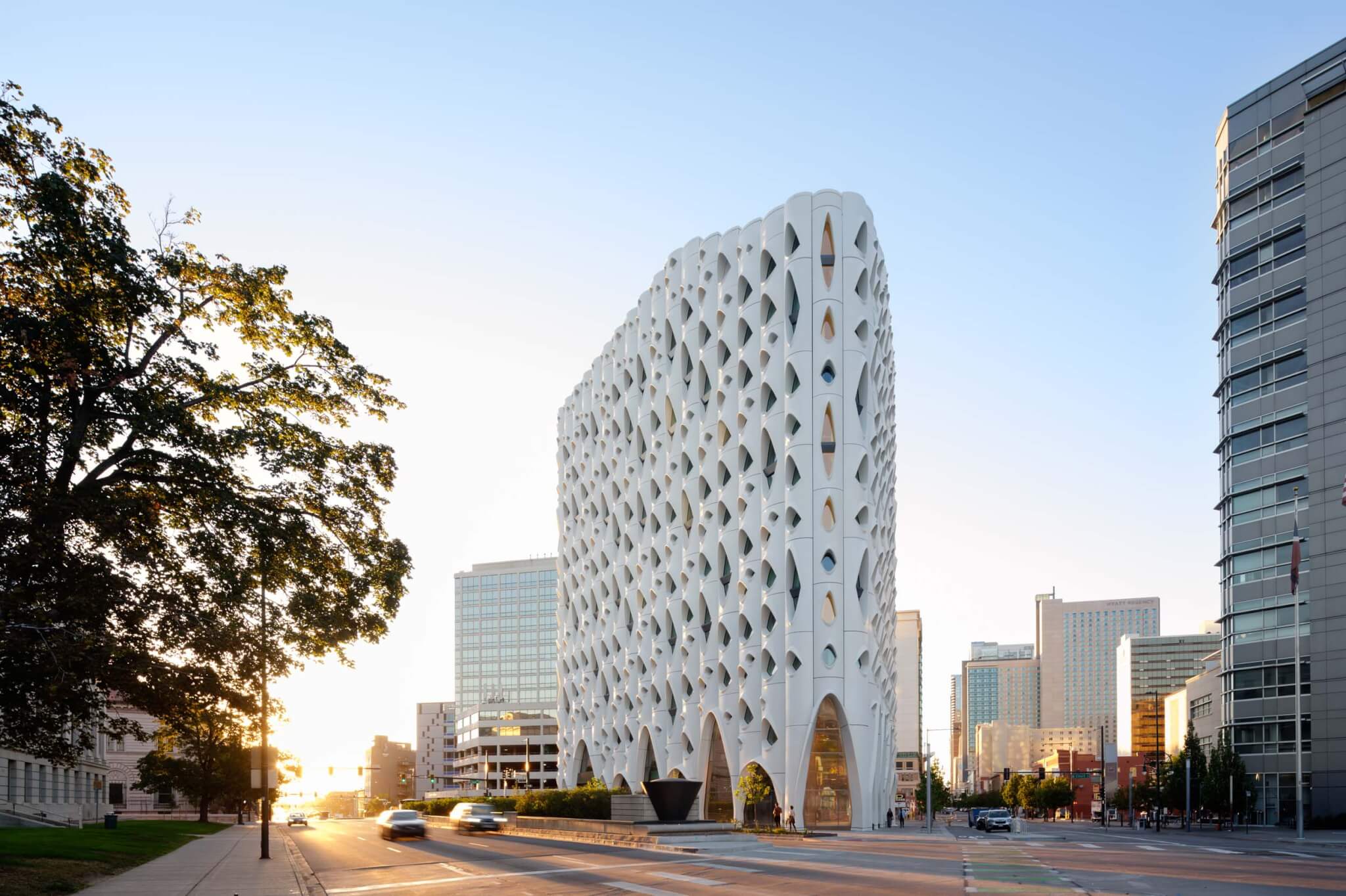Is the carbon in the room with us? It certainly is at the Studio Gang–designed Populus hotel in Denver, which claims to be the first “carbon positive” hotel in the United States. But there is also less of it than in a standard hospitality suite.
Rising 13 stories above the city’s civic center—concentrated around a City Beautiful–era park that hosts buildings like the Michael Graves–designed public library on one side and cultural buildings like the Gio Ponti, Daniel Libeskind, and Machado Silvetti and Fentress Architects–designed Denver Art Museum on the other—Populus is a triangular scallop-edged structure on a small site once home to Denver’s first gas station. Although there is an existing lot across the street for any visitors not using public transit or car service, the irony is not lost that this hotel is now the city’s first built without dedicated parking.

In a capital where most architecture skews largely rectilinear, Populus’s curvilinear figure is a welcome shape. The name Populus takes inspiration from Colorado’s widespread Aspen trees (Populus tremuloides); as does its facade. Fluted to recall the recognizable slim, white trunks, the glass-fiber reinforced concrete forms a series of “eyes.” The resulting lidded windows contribute to self-shading and rainwater diversion on the outside and offer curved seats inside a selection of the 265 hotel rooms. This design is “a combination of environmental, experiential, and conceptual factors,” said Studio Gang partner Juliane Wolf, and just one of the features that contributes to the headline-making sustainability efforts of building developer, Urban Villages.
The company defines “carbon positive” as a “commitment to sequester more carbon in biomass and soil than the combined embodied and operational footprints of the building throughout its entire lifecycle.” It’s a lofty goal—and one they have achieved, on a technicality: 7,000 mTCO2e of certified carbon credits. These offsets, in combination with the over 70,000 new trees Populus has sponsored to reforest Gunnison County, Colorado, with the United States Forest Service and its use of 100 percent renewable electricity from Colorado wind farms, bring the hotel over the line of its 6,675 mTCO2e of embodied greenhouse gas contributions.

As AN previously reported, Studio Gang’s team did some work on the front end to reduce the design’s embodied carbon. Using ECOPact concrete, which mixes in the coal plant byproduct fly ash, lowers the material’s CO2 emissions by about 30 percent. It’s still cement (up to 8 percent of all global emissions come from this material’s production for buildings) but after exploring a lower impact timber option for the building structure as well, Wolf said the concrete won out for its durability and thermal mass capabilities that allow it to lessen overall need for heating and cooling. Choosing to leave this material exposed in the guest rooms and around the elevator core also eliminated wallcoverings that would add to the carbon count. Finally, there is of course a native green roof by Superbloom contributes to local biodiversity and creates a cooling effect during Denver’s 252 annual days of sunshine.

Where possible, interior designer Heather Wildman also selected local or recycled products to achieve the hotel’s eco-friendly vibe, like the former snow fences from Wyoming installed overhead in the lobby and ground-floor restaurant, Pasque. Pasque is one of the hotel’s two eateries where food waste goes to a rare on-site commercial biodigester and comes out as fertilizer that will be donated to local farms. Cork wraps the hallways; biodegradable carpet covers guest rooms floors; a salvaged tree has been transformed into a reception desk by local company Urban WoodWorks; 500 sheets of Reishi, MycoWorks’s mushroom leather product, hang above the bar. “We started the design specifying local, less carbon-heavy products,” said Wildman. “In Colorado, there are so many options. That helps.”


There are carbon-contributing materials elsewhere in the hotel, hence the need for the data-driven offsets. Overall, designing and operating a truly sustainable project is an exercise in choices. “We didn’t always go to the lowest carbon footprint, but we always ask that question: Is there an alternative to achieve our goals?” said Urban Villages president Jon Buerge. For the typically wasteful hospitality industry, Populus is a step in the right direction. However, achieving a truly net positive impact on climate change will require changes in the demands we make of those doing the calculations.
Elizabeth Fazzare is a New York–based editor and journalist who covers architecture, design, culture, and travel for publications including Architectural Digest, Dwell, and Interior Design. She was previously the senior architecture and design editor at Cultured magazine, and an editor at Architectural Digest.

